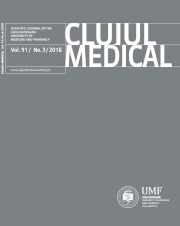ELECTROLYZED SALINE... AN ALTERNATIVE TO SODIUM HYPOCHLORITE FOR ROOT CANAL IRRIGATION
DOI:
https://doi.org/10.15386/cjmed-863Keywords:
irrigation, electrolyzed salineAbstract
Objectives. The aim of this study is to evaluate electrolyzed saline, produced from a custom-made chair side apparatus for its cleaning effect on root canal walls.
Methods. A chair side apparatus has been designed to produce and dispense electrolytically activated solutions (Electrolyzed saline) for the purpose of root canal irrigation. Two different solutions, one, which is oxidizing in nature, consisting primarily of Chlorine derivatives and another, reducing in nature, consisting primarily of sodium hydroxide, are obtained. A combination of these two solutions was used for root canal irrigation in extracted teeth. Root canals were split and the samples were subjected to Scanning electron microscopic evaluation.
Results. Under the conditions of this study, electrolyzed saline significantly cleaned the root canal surfaces well, opening the dentinal tubules and removing the smear layer.
Significance. There has been a constant search for the ideal root canal irrigant. Sodium hypochlorite has been vastly used but its toxicity and storage risks are of concern. Electrolyzed saline has been produced from saline and the apparatus prepares and dispenses the solution chair side, obviating storage needs.
Downloads
Additional Files
Published
How to Cite
Issue
Section
License
The authors are required to transfer the copyright of the published paper to the journal. This is done by agreeing to sign the Copyright Assignment Form. Whenever the case, authors are also required to send permissions to reproduce material (such as illustrations) from the copyright holder.

The papers published in the journal are licensed under a Creative Commons Attribution-NonCommercial-NoDerivatives 4.0 International License.

